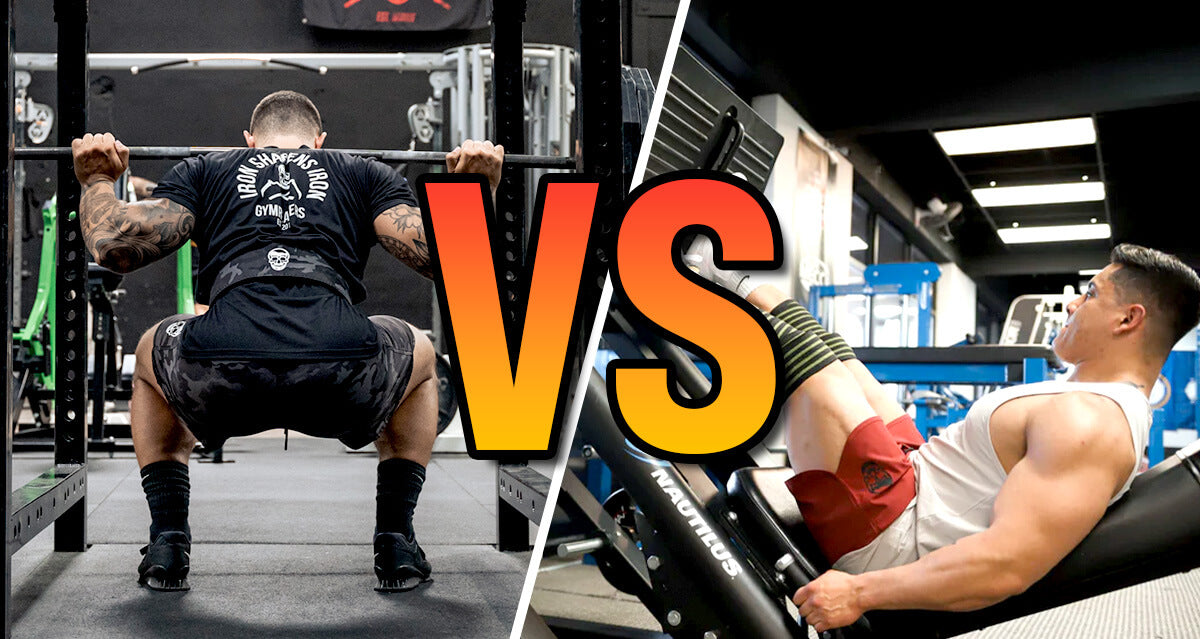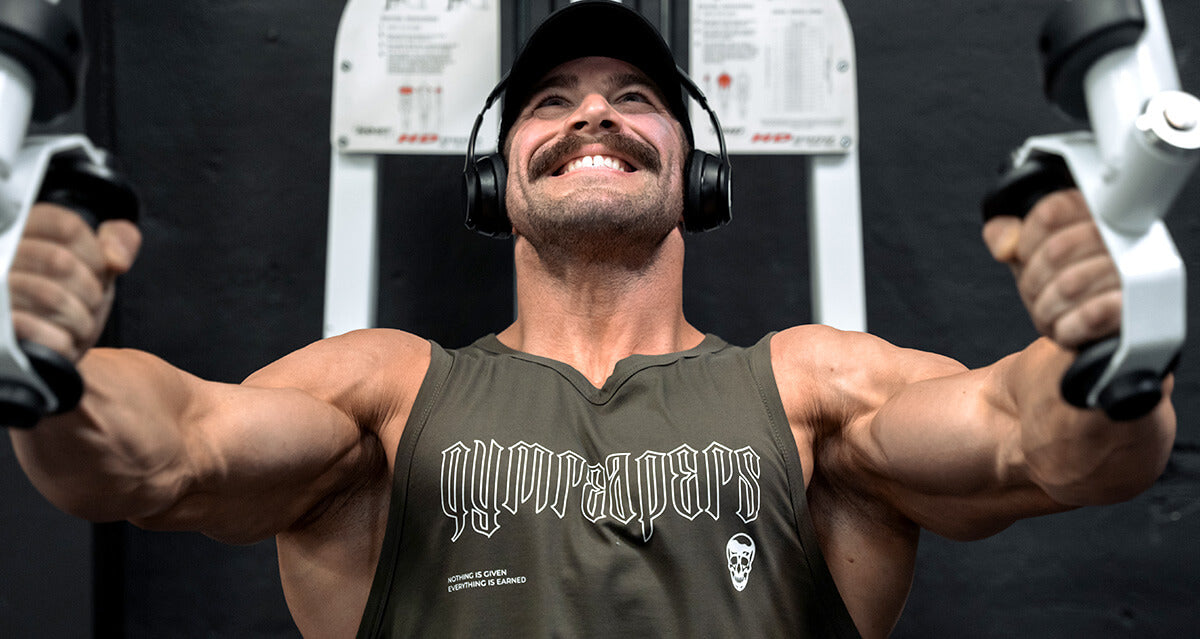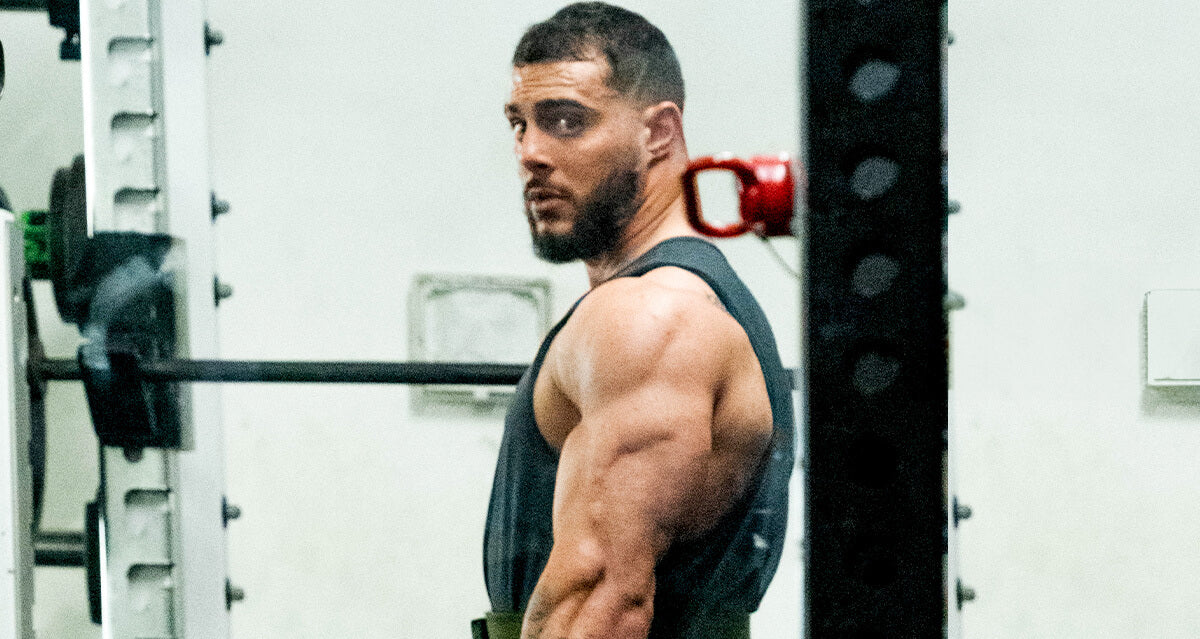If you want to build stronger legs, you’re probably wondering which lower-body exercise, the leg press or the squat, will reap the biggest rewards.
In this article, I’ll compare leg presses and squats, detailing their techniques, benefits, and drawbacks. By the end, you'll have a clear understanding of which exercise is better for your specific needs and whether you can incorporate both into your workout routine.
Key Takeaways
Leg Press
What Is It?
The leg press is a machine-based exercise that targets the lower body, primarily the quadriceps, adductors, and glutes. It involves pushing a weighted platform away from the body using the legs.
There are different variations of the leg press, including angled leg presses (45-degree) and horizontal leg presses. In some variations, you can adjust the footplate and torso pad angles to change muscle recruitment.
How To
- Sit on the leg press machine and position your feet shoulder-width apart on the platform.
- Ensure your back is fully supported, and adjust the seat to go as deep as your hip mobility allows.
- Release the safety handles and extend your legs without hyperextending your knees.
- Inhale and slowly lower the platform towards your chest by bending your knees.
- Keep your heels firmly planted throughout the entire movement.
- Exhale and press the platform back to the starting position by extending your legs.
Pro Tip
Altering your foot positioning can change which lower body muscles are targeted.
For example, if you want to focus more on your adductors (inner thighs), use a wider foot position.
To “isolate” your quads, keep your feet hip-width apart and place them lower on the footboard so that your knees are more bent in the bottom position.
To emphasize your glutes, narrow your foot position on the footboard and place your feet higher so your knee angle is closer to 90 degrees at the bottom of the movement.
Benefits
The benefits of the leg press are:
- It isolates the leg muscles. This exercise isolates the quads, glutes, and adductors and removes the need for balance and stability, allowing the lifter to push closer to failure safely.
- It reduces strain on the lower back. As less trunk bracing is required, there is much less compression on the lower back and a lower risk of injury.
- It’s beginner-friendly. The leg press is more suitable for beginners because it requires less movement coordination and has minimal setup.
Drawbacks
The drawbacks of the leg press are:
- It has a limited range of motion. The leg press has a restricted range of motion compared to squats, which limits overall lower body strength.
- It does not improve stability or coordination. The leg press does not challenge you to coordinate your posture and position in the exercise; it holds your body in place, and all you need to do is extend your legs.
- It does not improve functional strength. The leg press is less functional than compound movements like squats, as it does not engage as many muscle groups or mimic real-life movements (e.g., squatting down to lift an object from the ground).
Benefits of Knee Sleeves for Leg Press
Adding knee sleeves to your leg press routine can boost your performance and protect your knees. These sleeves offer compression that stabilizes the knee joint, making it easier to control your movements and lift heavier weights. They also help keep your knees aligned properly, reducing strain and lowering the risk of injury.
While knee sleeves are not a cure-all for knee problems, they can enhance your leg press workout by providing added support and confidence. For a deeper dive into the benefits of knee sleeves, check out our article "5 Benefits of Knee Sleeves for Lifting (According to Science)".
Squat
What Is It?
The squat is a fundamental lower body exercise that involves lowering your body from standing to sitting and returning to standing. It primarily targets the quadriceps, glutes, and adductors but also challenges your core and back muscles to balance and maintain your posture.
How To
- Position the barbell across your upper back and grip it with your hands wider than shoulder-width.
- Stand with your feet shoulder-width apart with toes slightly turned outward.
- Take a big breath and brace, then unrack the barbell and walk it out.
- Sit down until your hip crease is at or below the top of your knee.
- Exhale and push through your legs to return to the starting position.
- Maintain control throughout the movement, ensuring your knees track in line with your toes (not caving in) and your spine stays neutral.
- Repeat for the desired number of repetitions.
Pro Tips
Ensure you have enough mobility at your ankles and hips before loading the squat with heavier weight. If you cannot perform a bodyweight squat without your lower back rounding or heels popping off the floor, you’re not ready to perform a goblet or barbell squat.
If you have the movement capacity to load your squat with heavy weight, your priority should be to keep your joints healthy to reap the benefits of the squat while minimizing the risk of injury.
Invest in quality gear like Gymreapers knee sleeves and lifting belts. These tools help enhance your performance and safety for squats, providing the necessary support and stability for heavy lifts.
VERIFIED LEVER BELT REVIEWS
Benefits
The benefits of squats are:
- They target multiple muscle groups. Squats provide a comprehensive workout that targets the quadriceps, hamstrings, glutes, and core and back muscles.
- They encourage core strength and stability. Squats require core strength and stability to keep your body in the proper position; training these movement capacities helps improve your posture and balance during various physical activities and exercises.
- They improve functional strength. Squats enhance functional movement, making everyday tasks such as lifting, bending, and climbing stairs easier and more efficient by mimicking natural body movements.
Drawbacks
The drawbacks of squats are:
- There is a higher risk of injury. If your form is incorrect or you fail to brace correctly, it can place undue stress on your joints and muscles, increasing the risk of injury.
- They require more mobility. Performing squats requires more mobility and flexibility, particularly in the hips, ankles, and knees, to achieve proper depth and alignment.
- They require more stability and coordination. Squats can be particularly challenging for beginners due to the need for balance, stability, and coordination throughout the entire movement.
Should You Wear a Lifting Belt When Squatting?
Wondering if a lifting belt is worth using for squats? The main advantage is its ability to increase intra-abdominal pressure (IAP). A study by Harman et al. (1989) shows that a lifting belt significantly boosts IAP, which helps stabilize your spine and reduces the risk of injury by minimizing compressive forces on your spinal discs. Essentially, the belt provides extra support, allowing you to lift more safely and effectively. For more insights on whether you should wear a lifting belt for squats, check out our article "Wearing A Lifting Belt For Squats: Should You Do It?".
Leg Press VS Squat: Key Differences
The six key differences between the leg press and the squat are:
Range of Motion
Squats offer a greater range of motion than leg presses, particularly at the hips, where the hips fully extend at the top for squats.
The greater the range of motion, the more muscles are recruited, and the more strength you have in a larger range of motion.
Muscles Worked
Both exercises target the quads, hamstrings, and glutes, but squats also engage the core and back muscles to help stabilize the exercise.
Squats can be viewed as a total body exercise, whereas the leg press is more of a lower body isolation exercise.
Equipment
The leg press requires a specialized machine, while squats can be performed with just your body weight or loaded with bands or free weights like dumbbells, kettlebells, and barbells.

Loading
Certain leg press machines are selectorized, meaning they have a finite amount of load you can use depending on the model. Other machines are plate-loaded, so you can put as much weight as you can handle as long as it fits on the machine.
You should be able to leg press more weight than you can squat because it is an isolated movement that does not have balance or stability requirements.
With the squat, you can use as much weight as you want, especially with barbell squats.
When loading the squat, you shouldn’t be going so heavy that your technique breaks down, but you should challenge yourself each week to give your body a reason to adapt and get stronger.
Difficulty
Squats are more challenging due to the need for balance, stability, and proper form. There is also a huge learning curve for managing posture (neutral spine) and learning how to brace correctly to create intra-abdominal pressure.
The leg press is beginner-friendly, and all you need to learn is how to position your feet on the pad and how to lock and unlock the platform (if using an angled leg press)
Use Cases
Leg presses are ideal for isolating leg muscles, while squats are better for overall lower body strength and functional fitness.
Are Leg Presses Or Squats Better?
The leg press is better for you if:
- you are a beginner
- you are a bodybuilder who wants to train to failure to grow your legs
- your quads are a limiting factor, and they need more isolation training
Squats are better for you if:
- you want to compete in strength sports such as powerlifting, weightlifting, and strongman
- you want to improve your strength and conditioning for sports
- you want to be more functionally fit and be stronger in everyday life

Can You Do Leg Press & Squats In The Same Workout?
You can do the leg press and squats in the same workout. However, there are pros and cons that you should consider before changing your current leg routine.
Pros
By performing squats and the leg press in the same workout, you can increase strength across different ranges of motion within your muscle lengths and break through strength plateaus.
If you’ve plateaued on your squat, adding the leg press can help you work on isolating the leg muscles that aren’t getting the required stimulus. In doing so, you can break through your squat plateau.
You can perform squats first and finish with the leg press, training close to failing to overload the muscles. This combination can lead to more balanced muscle development and help you overcome plateaus by providing varied stimuli to your muscles.
Cons
Both exercises heavily target the quadriceps, hamstrings, and glutes, leading to significant muscle fatigue. This fatigue could impair your performance in the latter exercise, especially if you push the first hard.
Additionally, performing both exercises in one session can be time-consuming. It may not leave room for other important exercises, creating an unbalanced workout routine if you are time-constrained.
Sample Workout
Here is how I recommend combining squats and the leg press in the same workout:
- Squats: 3 sets of 6 reps
- Leg Press: 3 sets of 10-12 reps
- Lunges: 3 sets of 8 reps per leg
- Single Leg Dumbbell Hip Thrust: 3 sets of 10 reps per leg
Can The Leg Press Replace Squats?
While the leg press can supplement squats, it should not entirely replace them due to the functional benefits and range of motion coverage provided by squats.















1 comment
Earl Gorton
Always helpful thanks
Leave a comment
All comments are moderated before being published.
This site is protected by hCaptcha and the hCaptcha Privacy Policy and Terms of Service apply.